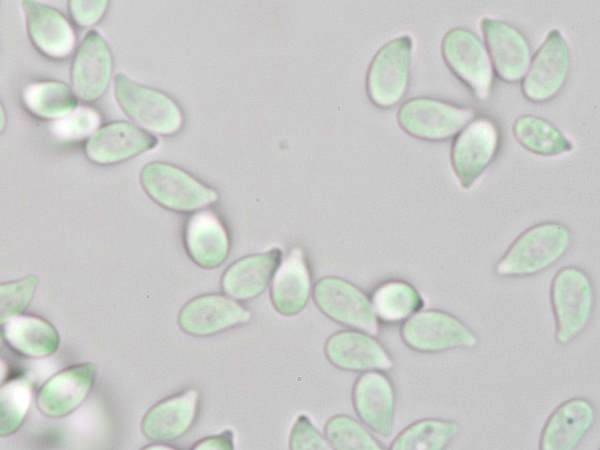Gymnopus ocior (Pers.) Antonín & Noordel. - Spring Toughshank
Phylum: Basidiomycota - Class: Agaricomycetes - Order: Agaricales - Family: Marasmiaceae
Distribution - Taxonomic History - Etymology - Identification - Culinary Notes - Reference Sources
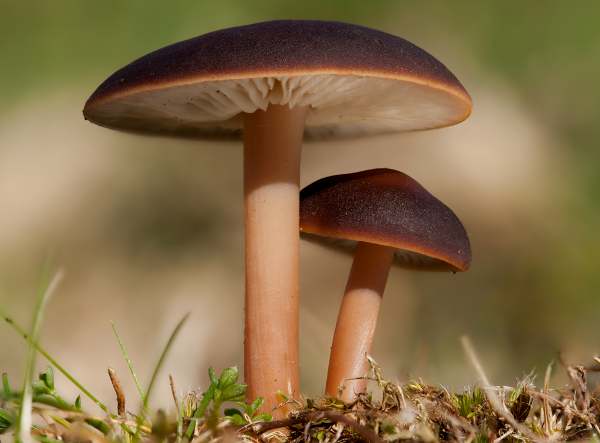
Such a beautiful mushroom... It is a crying shame that Gymnopus ocior is so rare in Britain and Ireland. This is also one of the neatest of the mushroom in the 'toughshank' group, which were all, until recently, grouped together in the genus Collybia. Many others in that group grow in tightly-packed tufts or lines so that the caps jostle one another into contorted shapes, making a perfect specimen are rarity. Gymnopus ocior, in contrast, seems to show the greatest respect for its neighbours.
Distribution
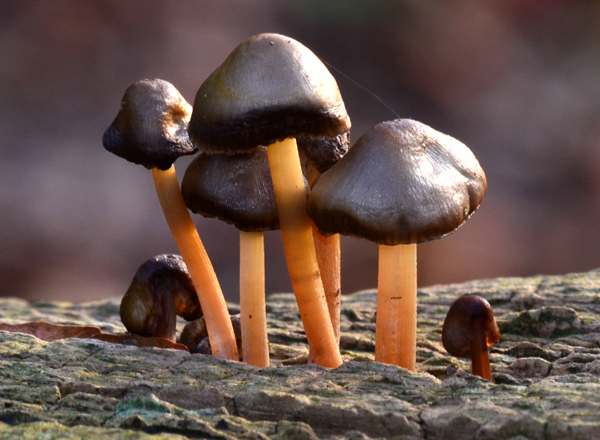
Gymnopus ocior is seen infrequently in woodland and parkland throughout Britain and Ireland. This strikingly beautiful mushroom is also found on the European mainland, where it is most common in northern countries, This species is also recorded in some parts of North America.
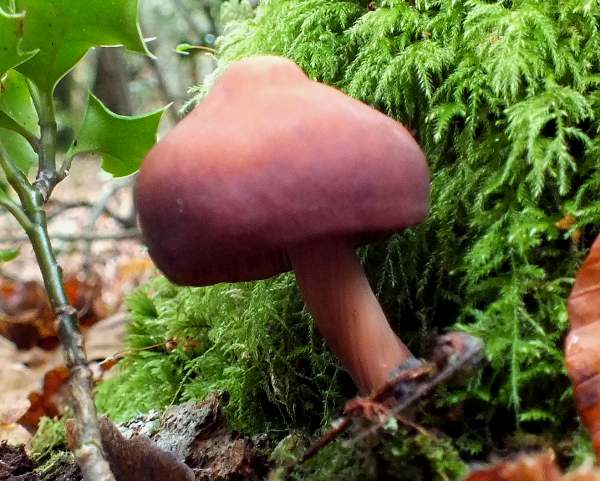
Until 1997, this mushroom had been recorded in most field guides as Collybia ocior, but work by Czeck mycologist Vladimir Antonín and Dutch mycologist Machiel Noordeloos has changed things greatly. In 1993 they published the first part of a monograph of the genera Marasmius and Collybia in Europe, and then in 1997 they radically reorganized the species into five genera - Collybia, Dendrocollybia, Gymnopus, Marasmiellus and Rhodocollybia. Molecular analysis has since supported their proposals, and recently-published field guides reflect these changes.
The beautiful group shown above was photographed by Van Greaves at Pipers Hill Wood near Bromsgrove/Hanbury, in Worcestershire, England during October 2013. Other pictures on this page are shown by courtesy of David Kelly.
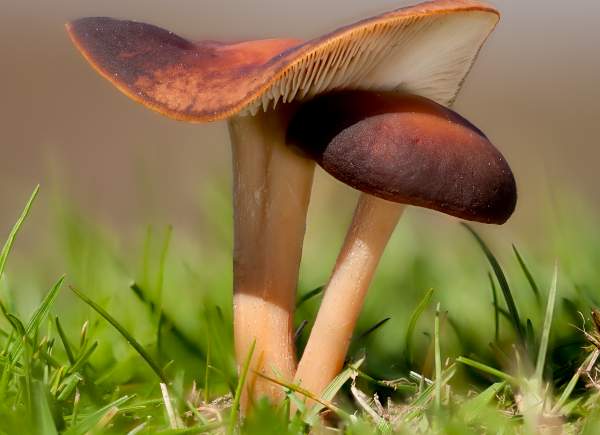
Taxonomic history
The basionym of this species dates from 1828, when Christiaan Hendrik Persoon described is scientifically and gave it the binomial name Agaricus ocior. The currently-accepted scietific name Gymnopus ocior was established in 1997 in a Mycotaxon publication by Antonin and Noordeloos.
Synonyms of Gymnopus ocior include Agaricus xanthopus Fr., Agaricus dryophilus ß funicularis Fr., Agaricus ocior Pers., Collybia extuberans (Fr.) Quél., Collybia succinea (Fr.) Quél., Collybia exsculpta (Fr.) Gillet, Collybia luteifolia Gillet, Collybia xanthopoda (Fr.) Sacc., Marasmius funicularis (Fr.) P. Karst., Gymnopus exsculptus (Fr.) Murrill, Marasmius exsculptus (Fr.) Rea, Collybia dryophila subsp. exsculpta (Fr.) Konrad & Maubl., Collybia dryophila var. funicularis (Fr.) Halling, and Collybia ocior (Pers.) Vilgalys & O.K. Mill.
Etymology
Gymnopus, the generic name, comes from Gymn- meaning naked or bare, and -pus meaning foot (or, in the case of a mushroom, stem). The specific epithet ocior means swifter or more rapid.
Despite its great beauty and the fact that it is fairly common, Gymnopus ocior has no common name in the British Mycological Society's list of English Names of Fungi.
Identification guide
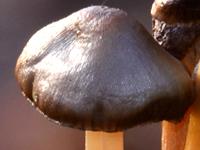 |
CapConvex, becoming shallowly convex or flattening with a wavy margin and sometimes developing a shallow central depression; 1.5 to 5cm across; dark reddish brown with usually a paler marginal zone; hygrophanous, drying out paler; margin not significantly striate. Cap flesh is thin and whitish. |
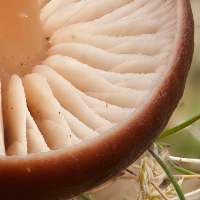 |
GillsWhite at first, becoming cream or yellowish with age; moderately crowded; adnexed to emarginate. StemCylindrical, smooth, slightly bulbous and finely hairy at the base; colour ochre to reddish-brown but significantly paler than the cap; 2 to 7cm long and 2 to 6mm in diameter; no stem ring. |
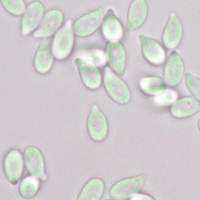 |
SporesEllipsoidal to oblong, 4.5-6 x 2.5-4μm; hyaline. Spore printWhite. |
Odour/taste |
Not distinctive. |
Habitat & Ecological role |
Saprobic on humous-rich soil in broadleaf and mixed woodland; also occasionally on wood chip mulch in parks and gardens. |
Season |
June to October in Britain and Ireland. |
Similar species |
Gymnopus dryophilus is a much paler toughshank which appears in clusters. |
Culinary Notes
Gymnopus ocior is recorded as 'edible but not worthwhile' in some field guides, but in any case these mushrooms are too tough to be tempting and are therefore not worth considering as a culinary collectible.
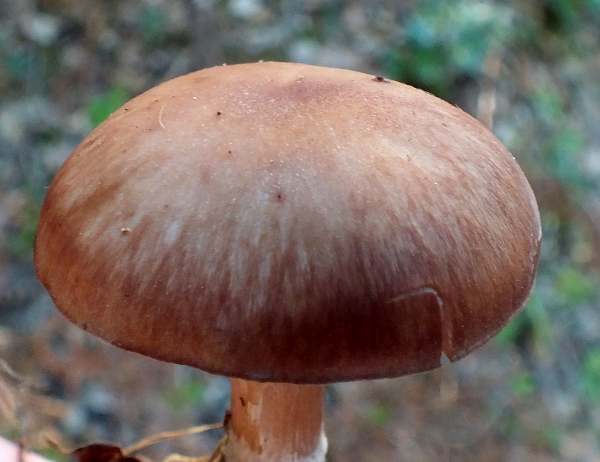
Reference Sources
Antonín, V.; Halling, R.E.; Noordeloos, M.E. 1997. Generic concepts within the groups of Marasmius and Collybia sensu lato. In: Mycotaxon 63:359–368
Fascinated by Fungi, 2nd Edition, Pat O'Reilly 2016, reprinted by Coch-y-bonddu Books in 2022.
Dictionary of the Fungi; Paul M. Kirk, Paul F. Cannon, David W. Minter and J. A. Stalpers; CABI, 2008
Taxonomic history and synonym information on these pages is drawn from many sources but in particular from the British Mycological Society's GB Checklist of Fungi.
Acknowledgements
This page includes pictures kindly contributed by Van Greaves and David Kelly.
Fascinated by Fungi. Back by popular demand, Pat O'Reilly's best-selling 450-page hardback book is available now. The latest second edition was republished with a sparkling new cover design in September 2022 by Coch-y-Bonddu Books. Full details and copies are available from the publisher's online bookshop...
